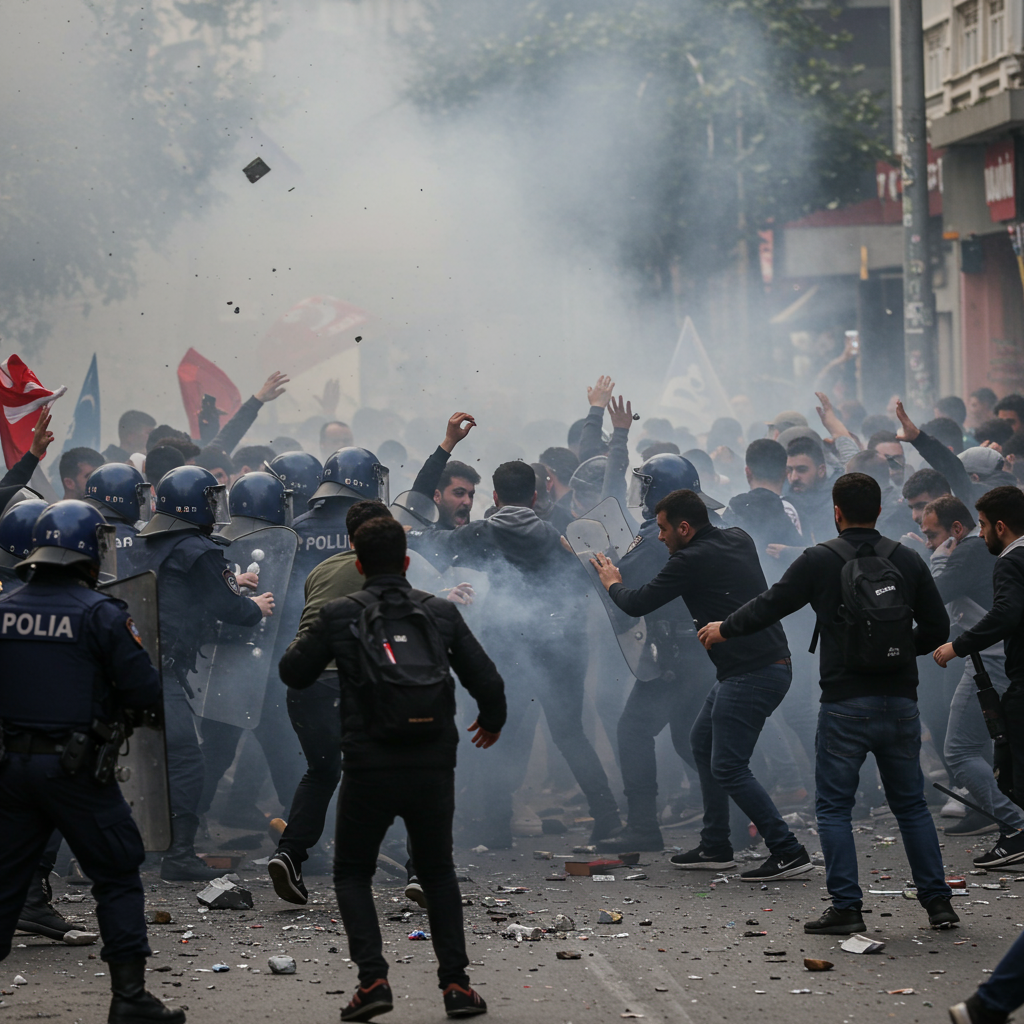Intense confrontations erupted in Istanbul on Monday, July 1, 2025, following allegations that the satirical magazine leman published a cartoon depicting the Prophet Muhammad. The controversial image quickly triggered widespread outrage, leading to street protests, clashes with police, and swift legal action resulting in multiple arrests of the magazine’s staff. This incident highlights the deep tensions surrounding freedom of expression and religious sensitivities in Turkey. Authorities and protesters condemned the cartoon as an insult to sacred values, while the magazine vehemently denied the accusation, claiming the image was deliberately misinterpreted.
Uproar Over a Satirical Drawing
The flashpoint was a cartoon featured in the weekly satirical magazine LeMan. Initial reports and public reaction quickly centered on the belief that the drawing included a depiction of the Prophet Muhammad. Such visual representations are widely considered forbidden and deeply offensive in Islam, leading to immediate and strong reactions from religious conservatives and government officials alike. The specific image reportedly showed two figures with wings floating above a scene of bombing, with one figure introducing himself as “Mohammed” and the other as “Musa” (Moses).
LeMan Magazine’s Counter-Claim
LeMan magazine’s editor-in-chief, Tuncay Akgun, along with the magazine itself, swiftly and strongly refuted the claims. They insisted the cartoon did not depict the Prophet Muhammad in any way. According to Akgun and statements from LeMan, the figure named “Muhammad” in the drawing represented a Muslim individual killed in Israeli bombardments. They emphasized the name Muhammad is extremely common, shared by over 200 million people globally, and argued that the work was a commentary on the plight of oppressed Muslims, not an insult to the Prophet. The magazine stated it would “never take such a risk” as depicting the Prophet.
Official Response and Legal Crackdown
Turkish authorities responded rapidly and decisively to the growing controversy. Istanbul’s chief public prosecutor launched an official investigation. The charge cited was “publicly insulting religious values,” an offense covered under Article 216 of the Turkish Penal Code. Arrest warrants were issued for key personnel at LeMan magazine.
Interior Minister Ali Yerlikaya announced on social media that police had arrested four staff members: the cartoonist responsible for the image (identified by the initials DP), the magazine’s graphic designer, its editor-in-chief, and its institutional director. Yerlikaya shared footage of the arrests, labeling the cartoon a “vile drawing” and calling the individuals responsible “shameless,” vowing they would be held legally accountable. Justice Minister Yilmaz Tunc also confirmed the investigation, stating that disrespect towards beliefs is unacceptable and that freedom does not permit making sacred values the subject of “ugly humour.”
Government Condemnation
High-ranking officials across the government joined in condemning the cartoon and the mentality behind it. Justice Minister Tunc asserted that any visual representation of the Prophet harms religious values and damages societal peace. Istanbul Governor Davut Gul criticized what he called the “mentality that seeks to provoke society by attacking our sacred values,” pledging that the state would not remain silent. Authorities also reportedly ordered the confiscation of the magazine issue and took steps to block its social media accounts and website within Turkey.
Street Protests and Clashes
As news of the cartoon and the official investigation spread, angry protests quickly materialized in Istanbul. Several dozen demonstrators initially gathered, targeting a bar in downtown Istanbul often frequented by LeMan staff. This led to immediate scuffles with police. The situation rapidly escalated, with the crowd size swelling to between 250 and 300 people near LeMan’s offices.
Riot police were heavily deployed to manage and disperse the protesters. According to reports, police fired rubber bullets and tear gas into the crowd. Demonstrators were heard chanting religious slogans, including calls for revenge. While authorities confirmed arrests of the magazine staff, specific details on arrests among the protesters were not immediately clear, though the governor mentioned some individuals engaged in “provocative actions.”
Historical Context and Ongoing Tensions
LeMan magazine, founded in 1991, is well-known for its sharp political satire and has a history of challenging conservative viewpoints. Notably, the magazine publicly supported the French satirical magazine Charlie Hebdo after its offices were attacked in Paris in 2015. That attack followed Charlie Hebdo’s publication of caricatures of the Prophet Muhammad. The comparison to the Charlie Hebdo incident was noted by LeMan’s editor-in-chief Akgun and others, underscoring the sensitive nature of such controversies and the potential for serious backlash, drawing parallels that Akgun described as “very intentional and very worrying.”
This event vividly illustrates the delicate balance between freedom of expression and the protection of religious sensibilities in Turkey. While satirical magazines operate, they often face legal challenges under laws prohibiting the insult of religious values. The swift state response, coupled with public outrage and clashes, highlights the ongoing intensity of this cultural and legal conflict within the country. Critics argue such actions can have a chilling effect on media freedom and satire.
Frequently Asked Questions
What caused the clashes and arrests related to LeMan magazine in Turkey?
Clashes and arrests in Istanbul on July 1, 2025, were sparked by a cartoon published in the satirical magazine LeMan. Authorities and many protesters alleged the cartoon depicted the Prophet Muhammad, which is deeply offensive in Islam. The Istanbul chief prosecutor ordered arrests based on charges of “publicly insulting religious values,” leading to confrontations between protesters and police near the magazine’s offices and a nearby bar.
Why is depicting the Prophet Muhammad controversial in Islam?
In Islam, many adherents believe that creating visual depictions of God and the Prophet Muhammad is forbidden. This prohibition is intended to prevent idolatry and maintain the divine and prophetic figures’ unique spiritual status. Satirical or perceived disrespectful depictions are particularly controversial and can provoke strong negative reactions and outrage among Muslims globally.
What was the magazine’s defense, and what happened to the staff?
LeMan magazine and its editor-in-chief, Tuncay Akgun, strongly denied that the cartoon depicted the Prophet Muhammad. They claimed the image fictionalized the name “Muhammad” to represent a Muslim individual killed in bombings, emphasizing the name’s commonality. LeMan argued the cartoon was misinterpreted to cause provocation and intended to highlight the plight of oppressed Muslims. Despite their defense, four staff members, including the cartoonist and editor-in-chief, were arrested by Turkish police following the official investigation.
Conclusion
The incident involving LeMan magazine’s controversial cartoon has ignited significant unrest in Istanbul. It has led to violent clashes between protesters and police and resulted in the arrest of magazine staff members under charges of insulting religious values. While LeMan maintains the cartoon was misunderstood and depicted a victim rather than the Prophet Muhammad, Turkish authorities and many citizens view the drawing as a grave offense against sacred beliefs. This event serves as a stark reminder of the persistent challenges facing freedom of expression when it intersects with deeply held religious sensitivities in Turkey, a tension that continues to shape the country’s societal and legal landscape.



